|
|
|
Sort Order |
|
|
|
Items / Page
|
|
|
|
|
|
|
| Srl | Item |
| 1 |
ID:
150004
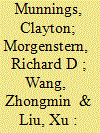

|
|
|
|
|
| Summary/Abstract |
To help overcome the challenge of growing CO2 emissions, China is experimenting with market-based instruments, including pilot CO2 emissions trading systems (ETSs) in seven regions that serve as precursors of a national CO2 ETS. Implementing an ETS in a rapidly growing economy in which government authorities exercise significant control over markets poses many challenges. This study assesses how well three of the most developed pilot ETSs, in Guangdong, Shanghai, and Shenzhen, have adapted carbon emissions trading to China's economic and political context. We base our study on new information gathered through interviews with local pilot ETS regulators and experts, analysis of recent trading data, and extensive legal and literature reviews. We point out instances in which pilot regulators have deftly tailored carbon emissions trading to China's unique context and instances in which designs are insufficient to ensure smooth operation. We also indicate areas in which broader institutional reforms of China's political economy may be required for carbon emissions trading to operate successfully. We make nine recommendations to improve the design and operation of the pilot programs and to inform the construction of a national CO2 ETS.
|
|
|
|
|
|
|
|
|
|
|
|
|
|
|
|
| 2 |
ID:
118018
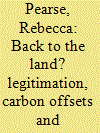

|
|
|
|
|
| Publication |
2013.
|
| Summary/Abstract |
Carbon offsets produced from terrestrial (land-based) emissions reduction projects are a contested frontier of carbon market expansion. Experiments in legislating for and producing terrestrial offsets that come under the title REDD+ have met heated opposition. However, a political consensus about the desirability and feasibility of carbon offsets from avoided deforestation and various land-management practices has slowly emerged. How do terrestrial carbon offsets gain legitimacy in the face of contestation and compelling evidence that creating carbon commodities from land ecosystems is an elusive commodity fiction? It seems that a quiet compromise is emerging over the (re-)commodification of land through carbon trading vis-à-vis the broader process of legitimating marketized climate policy. This paper offers a political-economic analysis of state-led efforts to legitimate a market for land carbon sinks in Australia and the Asia-Pacific region. The dynamics of legitimation and contestation play out as an iterative 'double movement'.
|
|
|
|
|
|
|
|
|
|
|
|
|
|
|
|
| 3 |
ID:
096742
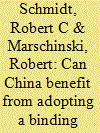

|
|
|
|
|
| Publication |
2010.
|
| Summary/Abstract |
In the run-up to the Copenhagen climate summit, the USA announced an emissions reduction target of 17% by 2020 (relative to 2005), and the EU of 20-30% (relative to 1990). For the same time horizon, China offered to reduce the CO2-intensity of its economy by 40-45% (relative to 2005), but rejects a legally binding commitment. We use the targets announced by the EU and the USA to analyze the potential gain for China if it were to adopt a binding emissions target and join an international emissions trading scheme. We show that China would likely benefit from choosing a binding target well below its projected baseline emissions for 2020.
|
|
|
|
|
|
|
|
|
|
|
|
|
|
|
|
| 4 |
ID:
186483
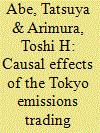

|
|
|
|
|
| Summary/Abstract |
The Tokyo emissions trading scheme (ETS) is the first regional ETS in Japan, where a national ETS has not been introduced. In this study, we estimate the policy impacts of the Tokyo ETS on energy usage and economic activities during the scheme’s first phase (2010–2014) and the first four years of its second phase (2015–2018) using business establishment-level panel data from 2007 to 2018. From the matching-based difference-in-differences (DID) estimation results, we find that while regulated business establishments reduced their energy usage beyond their reduction targets set by ETS regulation, the unregulated business establishments chosen by the matching strategy as a comparison group also decreased their energy usage to the same extent. Additionally, the Tokyo ETS did not have a negative impact on the economic activities of regulated business establishments during phases I and II. These results suggest that the emissions cap levels in each phase may not have been sufficiently demanding to induce regulated business establishments to implement additional energy use reduction practices.
|
|
|
|
|
|
|
|
|
|
|
|
|
|
|
|
| 5 |
ID:
149932
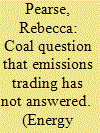

|
|
|
|
|
| Summary/Abstract |
Can emissions trading assist with the task of placing a limit on coal production and consumption in Australia? This paper outlines a critical political economy perspective on coal and a flagship ‘market mechanism’ for emissions reduction. The prospects for an effective emissions trading scheme in coal-dominated economies are considered in light of its theoretical justifications as well as recent attempts to price carbon in Australia. Emissions trading is a weak instrument that does not address real-world failures of coal governance. At their theoretical best, carbon prices produce marginal changes to the cost structure of production. In practice, the Australian case demonstrates emissions trading is an attempt to displace the emissions reduction task away from coal, through compensation arrangements and offsetting. In light of the urgent need to rapidly reduce global emissions, direct regulation and democratisation of coal production and consumption should be flagship climate policy.
|
|
|
|
|
|
|
|
|
|
|
|
|
|
|
|
| 6 |
ID:
149931


|
|
|
|
|
| Summary/Abstract |
This article questions the assumption that carbon markets create a level playing field by exploring the relationship between the organisation of capital and the organisation of emissions in the European Union Emissions Trading System (EU ETS). It constructs a database by matching installations and owners to reveal that a relatively small number of large-scale coal-fired power stations, owned by a very small group of states and corporations, are responsible for a significant proportion of greenhouse gas emissions. The findings are analysed by considering how technological dependence on coal together with the corporate institutional form combine to support the socio-spatial concentration and centralisation of capital and emissions. Case studies of the consolidation of the seven largest polluting owners from Europe's coal-dependent electricity sector and the carbon trading strategies of the two largest polluters, RWE and E.ON, then assess the impacts of energy liberalisation and emissions trading policies. The article concludes that EU energy and climate policies are pulling in different directions by clustering responsibility for greenhouse gas emissions and diffusing responsibility to address climate change. The uneven distribution of emissions within the EU ETS makes an alternative policy approach that directly targets the biggest corporate and state polluters both feasible and necessary.
|
|
|
|
|
|
|
|
|
|
|
|
|
|
|
|
| 7 |
ID:
097480
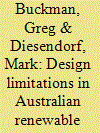

|
|
|
|
|
| Publication |
2010.
|
| Summary/Abstract |
Renewable electricity is pivotal to the medium and long-term reduction of Australia's greenhouse gas (GHG) emissions, if deep cuts in them are eventually implemented. This paper examines the effectiveness of the principal existing policies that could potentially promote the expansion of renewable electricity (RElec) in Australia: the expanded Renewable Energy Target (RET); the proposed emissions trading scheme (ETS); and the state and territory-based feed-in tariffs. We find the effectiveness of RET is severely eroded by the inclusion of solar and heat pump hot water systems; by the inclusion of 'phantom' tradable certificates; and by high electricity consumption growth. We also find that the ETS will not produce a high enough carbon price to assist most RElec technologies before 2020; and that most of the feed-in tariffs exclude large-scale RElec and will give little assistance to small-scale RElec because they are mostly net tariffs. Unless there is a major revision of its RElec policy mechanisms, Australia will fail to reach its renewable electricity target and in particular will fail to build up its solar generation capacity which could be a major source of future deep cuts in the country's electricity generation emissions.
|
|
|
|
|
|
|
|
|
|
|
|
|
|
|
|
| 8 |
ID:
096646
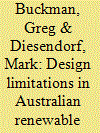

|
|
|
|
|
| Publication |
2010.
|
| Summary/Abstract |
Renewable electricity is pivotal to the medium and long-term reduction of Australia's greenhouse gas (GHG) emissions, if deep cuts in them are eventually implemented. This paper examines the effectiveness of the principal existing policies that could potentially promote the expansion of renewable electricity (RElec) in Australia: the expanded Renewable Energy Target (RET); the proposed emissions trading scheme (ETS); and the state and territory-based feed-in tariffs. We find the effectiveness of RET is severely eroded by the inclusion of solar and heat pump hot water systems; by the inclusion of 'phantom' tradable certificates; and by high electricity consumption growth. We also find that the ETS will not produce a high enough carbon price to assist most RElec technologies before 2020; and that most of the feed-in tariffs exclude large-scale RElec and will give little assistance to small-scale RElec because they are mostly net tariffs. Unless there is a major revision of its RElec policy mechanisms, Australia will fail to reach its renewable electricity target and in particular will fail to build up its solar generation capacity which could be a major source of future deep cuts in the country's electricity generation emissions.
|
|
|
|
|
|
|
|
|
|
|
|
|
|
|
|
| 9 |
ID:
091564
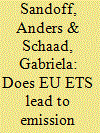

|
|
|
|
|
| Publication |
2009.
|
| Summary/Abstract |
The first trading period of the European Emissions Trading Scheme (EU ETS) has recently come to an end. The experiences of the actors in the trading sector will be of great importance in evaluating the aim and direction of this "Grand Policy Experiment". This paper gives an account of the attitudes and actions of the companies included in the Swedish emissions trading sector after about 15 months of experience with the system. The data are based on a study commissioned by the Swedish Environmental Protection Agency, and is a comprehensive survey that encompasses all companies operating installations included in the Swedish Emission Trading Registry. However, the results point in a somewhat disquieting direction. Although the Swedish companies have shown significant interest in reducing emissions, this survey indicates that this is done without close attention to the pricing mechanism of the market-based instruments. If this praxis is widespread within the European trading sector, it can have a serious negative effect on the efficiency of the system.
|
|
|
|
|
|
|
|
|
|
|
|
|
|
|
|
| 10 |
ID:
136186
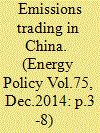

|
|
|
|
|
| Summary/Abstract |
China has implemented emissions trading schemes in seven cities and provinces, and is planning a national cap-and-trade scheme. The seven pilot schemes show marked differences in design and operate in very diverse economic circumstances. Challenges encountered in the pilot schemes include the risk of over-allocation of emissions permits, unpredictable underlying growth trends, robust measurement and verification procedures, and the interaction with regulation in the energy sector. In addition, experiences from developed countries’ emissions trading schemes, in particular the EU ETS, can help inform the decisions about the design of a future Chinese national scheme. We find that Chinese policymakers will need to pay particular attention to the operation of emissions trading in a heavily regulated electricity sector. Setting emission caps in the context of a national emissions intensity target creates specific difficulties. Related price developments are uncertain and depend largely on underlying emissions growth rates. The option of auctioning permits and using the proceeds for other purposes is not taken into consideration extensively. Finally, implementing reliable systems for monitoring, reporting and verification of emissions remains a major task. This paper serves as an introduction to the special issue “Emissions trading in China” and draws on insights from the papers in the special issue.
|
|
|
|
|
|
|
|
|
|
|
|
|
|
|
|
| 11 |
ID:
136195
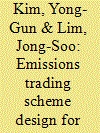

|
|
|
|
|
| Summary/Abstract |
The electricity market, monopolistic in nature, with government price regulation, poses a serious challenge for policy makers with respect to the cost-effectiveness of emissions trading, particularly in Asian countries. This paper argues that a cap-and-trade regulatory system for indirect emissions combined with a rate-based allocation system for direct emissions can achieve market efficiency even in the presence of price and quantity controls in the electricity market. This particular policy mix could provide appropriate incentives for industries to reduce their electricity consumption while inducing power producers to reduce their direct carbon emissions cost-effectively in conditions where there is strict government control of electricity prices. Another advantage of the suggested policy mix is that it allows carbon leakage in cross-border power trades to be effectively eliminated.
|
|
|
|
|
|
|
|
|
|
|
|
|
|
|
|
| 12 |
ID:
096645
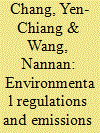

|
|
|
|
|
| Publication |
2010.
|
| Summary/Abstract |
This paper begins with the international context concerning climate change and how China fits into this context. Concentration is then turning into the emissions control system in China including environmental planning, legislation, policy instruments and measures as well as institutional setting in China's environmental governance system. Special attentions also being paid to emissions control in China's power sector. It should be noted that the pollution discharge permit system in China only exists superficially in many places. Insufficient resources are applied to the implementation of the said permit system, which in turn means that the system is applied according to differing standards in different parts of the country. The findings of this paper suggested that emissions trading programmes are usually introduced alongside the existing policies. The power sector usually has numerous other policy objectives and therefore the design and implementation of emissions trading programmes in the sector will have to address concern about the compatibility of existing industry policies.
|
|
|
|
|
|
|
|
|
|
|
|
|
|
|
|
| 13 |
ID:
097479
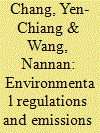

|
|
|
|
|
| Publication |
2010.
|
| Summary/Abstract |
This paper begins with the international context concerning climate change and how China fits into this context. Concentration is then turning into the emissions control system in China including environmental planning, legislation, policy instruments and measures as well as institutional setting in China's environmental governance system. Special attentions also being paid to emissions control in China's power sector. It should be noted that the pollution discharge permit system in China only exists superficially in many places. Insufficient resources are applied to the implementation of the said permit system, which in turn means that the system is applied according to differing standards in different parts of the country. The findings of this paper suggested that emissions trading programmes are usually introduced alongside the existing policies. The power sector usually has numerous other policy objectives and therefore the design and implementation of emissions trading programmes in the sector will have to address concern about the compatibility of existing industry policies.
|
|
|
|
|
|
|
|
|
|
|
|
|
|
|
|
| 14 |
ID:
169861
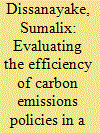

|
|
|
|
|
| Summary/Abstract |
Using the energy-environmental version of the Global Trade Analysis Project, this study compares the effects of three carbon emissions mitigation strategies – a carbon tax, a fuel tax and an emissions trading scheme (ETS) to combat the intended emissions target for Indonesia, a large emitting developing country. Although the fuel tax was found to raise economic growth by 0.29% in 2030, the carbon tax and ETS which reduce economic growth by about 0.11% have less adverse effects on inflation, welfare loss, wage decline, and employment loss. Unlike the fuel tax, the carbon tax and ETS are also likely to promote substitution towards renewable energy given the massive increase in the price of coal of over 100% due to the carbon tax and ETS. To meet Indonesia's emissions target, a carbon tax of US$36/ton of CO2 is needed. The carbon tax which is simpler and more swiftly implementable is the more practical choice compared to the ETS in the short to medium term for developing countries with political economy constraints in their energy and transportation sectors.
|
|
|
|
|
|
|
|
|
|
|
|
|
|
|
|
| 15 |
ID:
192395
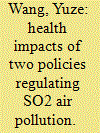

|
|
|
|
|
| Summary/Abstract |
In developing countries widespread air pollution poses a major threat to public health calling for effective environmental regulation. This paper adds to the limited literature on the health impact of different environmental regulations. Using data from eight waves of the China Health and Nutrition Survey (1993–2015), we employ a difference-in-differences model to investigate the health impact of two policies combatting SO2 air pollution: the command-and-control environmental regulation represented by the Two Control Zones (TCZ) and the market-oriented environmental regulation represented by the SO2 Emissions Trading Scheme (ETS). The main findings are that the TCZ policy resulted in a 39% reduction in the 4-week prevalence of air pollution-related diseases through channels such as reducing industrial SO2 emissions and industrial fumes emissions, and increasing individuals' amounts of physical exercise. In contrast, the ETS had no positive health effects, likely due to imperfect market mechanisms and environmental policy uncertainties. The health impact of the TCZ was most pronounced for respiratory illnesses, and was increasing over the period during which the policy was implemented. The positive health impact is stronger for outdoor, less educated, and lower income workers. Residents in Eastern regions and urban areas (especially the rural hukou holders living there) benefitted more from the environmental regulation.
|
|
|
|
|
|
|
|
|
|
|
|
|
|
|
|
| 16 |
ID:
094856


|
|
|
|
|
| Publication |
2010.
|
| Summary/Abstract |
This paper estimates the value of international emissions trading, focusing on a here-to-fore neglected component; its value as a hedge against uncertainty. Much analysis has been done of the Kyoto Protocol and other potential international greenhouse gas mitigation policies comparing the costs of achieving emission targets with and without trading. These studies often show large cost reductions for all Parties under trading compared to a no trading case. We investigate the welfare gains of including emissions trading in the presence of uncertainty in economic growth rates, using both a partial equilibrium model based on marginal abatement cost curves and a computable general equilibrium model. We find that the hedge value of international trading is small relative to its value in reallocating emissions reductions when the burden sharing scheme does not resemble a least cost allocation. We also find that the effects of pre-existing tax distortions and terms of trade dominate the hedge value of trading. We conclude that the primary value of emissions trading in international agreements is as a burden sharing or wealth transfer mechanism and should be judged accordingly.
|
|
|
|
|
|
|
|
|
|
|
|
|
|
|
|
| 17 |
ID:
150830
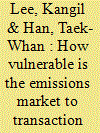

|
|
|
|
|
| Summary/Abstract |
The impact of transaction costs on the early emissions trading market is examined by applying an agent-based model and simulation (ABMS) approach. For a realistic model set up, bounded rationality, stochastic characteristics, and learning-by-doing are considered in our search processes. Marginal abatement cost parameters are obtained from Yoo et al. (2010), which is an experimental study on the emissions trading in the Korean power sector. Sensitivity analyses are performed on market performance indices with regard to transaction cost parameters, which represent scales and the learning elasticities of transaction costs. A total of 960 simulations were run in this sensitivity analysis. Sensitivity analysis results consistently show that higher transaction costs worsen market performance. The most remarkable finding in these results is that welfare performance of all the transactions decreases by up to 50% as the scale parameters of transaction costs increase, implying that welfare gain from introducing emissions trading disappears significantly. However, with learning curve effect, welfare performance could be regained by up to 26%. In sum, although transaction costs significantly encroach upon trade gains at the early stage, based on our simulation results, the welfare loss by way of transaction costs is lessened as the knowledge of market participants progresses.
|
|
|
|
|
|
|
|
|
|
|
|
|
|
|
|
| 18 |
ID:
116923
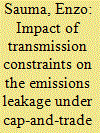

|
|
|
|
|
| Publication |
2012.
|
| Summary/Abstract |
Several regional cap-and-trade (C&T) programs are considered or implemented in the United States to control greenhouse gas emissions from the power sector. One concern is the possibility of emissions leakage due to a lack of coherence in the geographic scope of the regional electricity market and the C&T program. Leakage in the context of regulating CO2 emissions is defined as the short-run displacement of CO2 emissions from the capped region to other uncapped regions due to the imposition of a regional C&T scheme. However, the presence of transmission congestion could interact with regulations in an unanticipated way to determining whether leakage would occur and its magnitude if happens. In this paper, we use a two-node network to study the conditions under which the CO2 leakage would happen in a radial network under a C&T program. These conditions are related to transmission capacity, merit order change, and relative production cost between capped and uncapped regions. Since CO2 leakage would likely occur in a radial network during the time when there is surplus transmission capacity, if regional CO2 policies could influence power grid management and operations decisions, then there might be space for a better multi-objective coordination.
|
|
|
|
|
|
|
|
|
|
|
|
|
|
|
|
| 19 |
ID:
115153
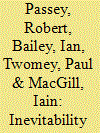

|
|
|
|
|
| Publication |
2012.
|
| Summary/Abstract |
The global climate policy environment is currently characterised by a small number of national or regional 'flagship' emissions trading schemes and a very large number of smaller more targeted 'flotilla' policies. We use an assessment framework to identify the characteristics of policies that affect their likelihood of introduction and alteration during the policy development process. We conclude that this mix of flagship and flotilla policies is at least in part an inevitable consequence of incumbent stakeholder pressure that results in flagship policies being blocked or weakened by those opposing action, and if weakened sufficiently, possibly blocked by those seeking stronger action. In contrast, smaller flotilla policies can be designed to have less impact on large incumbents and/or be of benefit to a different group of stakeholders who then provide political support. As a result, flotilla policies are likely to remain as key elements of the climate policy mix, to reduce emissions beyond those achieved by flagship policies, and to reduce emissions where no flagship policies exist. These findings have two consequences for policy design: the need to ensure that flagship policies do not reduce the effectiveness of flotilla policies, and that flagship policies are capable of being enhanced over time.
|
|
|
|
|
|
|
|
|
|
|
|
|
|
|
|
| 20 |
ID:
088054


|
|
|
|
|
| Publication |
2009.
|
| Summary/Abstract |
Several western states have considered developing a regulatory approach to reduce greenhouse gas (GHG) emissions from the electric power industry, referred to as a load-based (LB) cap-and-trade scheme. A LB approach differs from the traditional source-based (SB) cap-and-trade approach in that the emission reduction obligation is placed upon Load Serving Entities (LSEs), rather than electric generators. The LB approach can potentially reduce the problem of emissions leakage, relative to a SB system. For any of these proposed LB schemes to be effective, they must be compatible with modern, and increasingly competitive, wholesale electricity markets. LSE's are unlikely to know the emissions associated with their power purchases. Therefore, a key challenge for a LB scheme is how to assign emissions to each LSE. This paper discusses the problems with one model for assigning emissions under a LB scheme and proposes an alternative, using unbundled Generation Emission Attribute Certificates. By providing a mechanism to internalize an emissions price signal at the generator dispatch level, the tradable certificate model addresses both these problems and provides incentives identical to a SB scheme.
|
|
|
|
|
|
|
|
|
|
|
|
|
|
|
|
|
|
|
|
|